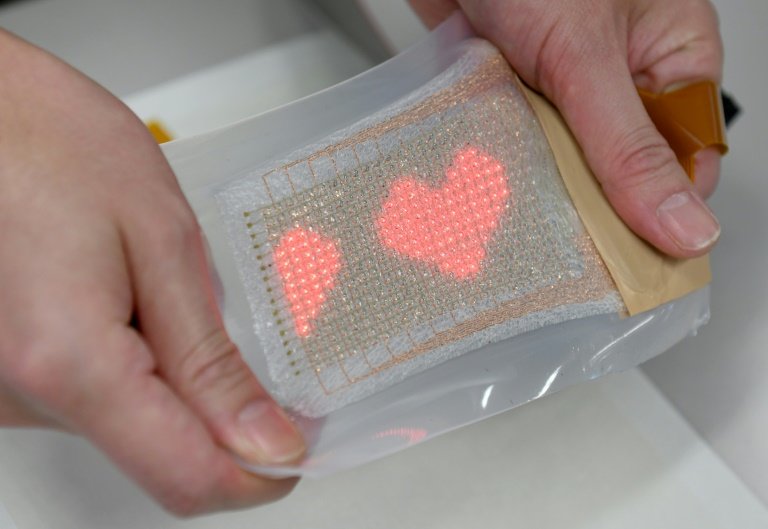Electronic skin from Japanese researchers shows heartbeat
A little more than half a year ago, Japan developed a method for producing electronics, which has breathability, does not irritate the skin, and weighs almost nothing. Otherwise, it is called "electronic skin".
Now, engineers have produced a prototype, the dimensions of which allow, firstly, to cover a sufficient body area to monitor the electrical activity of the cardiac activity, and secondly, they allow to place flexible displays for visual, on-line monitoring of the obtained data.

')
The display, jointly developed by researchers at the Graduate School of Engineering at the University of Tokyo and the leading Japanese printing company Dai Nippon Printing (DNP), consists of 16 x 24 microchips and stretchable electrical wiring. It stretches 45% of the original length.
The sensor system is made of thin gold nanofibers that transmit electrical current, and a water-soluble polymer - polyvinyl alcohol (PVA). When the device is applied to wet skin, the base of polyvinyl alcohol is stretched and the gold fibers “adjust” to the skin pattern.
Polyvinyl alcohol is an emulsifying, adhesive and film-forming polymer. It has high tensile strength and flexibility. These properties depend on the humidity of the air, since the polymer adsorbs moisture and becomes more flexible. Water acts on the polymer as a plasticizer. Polyvinyl alcohol is stable against oils, fats and organic solvents. With high humidity in PVA decreases the tensile strength, but increases the elasticity.
The display is much more resistant to wear and stretching than previous wearable displays. It is designed to minimize the stress that occurs when stretching at the junction of solid materials, such as microdiodes, and soft materials, which include elastic wiring. During the tests, no “pixel” has failed, and this makes it possible to call it the first tensile display, which ensures long-term operation in real mode. A nanomechanical sensor developed earlier with this “skin” can be worn continuously for a week without causing inflammation. The sensor itself first registered an electrocardiogram. It is also able to measure the temperature, pressure and bioelectric activity of the muscles.

Dai Nippon Printing aims to bring the skin display to the market over the next three years, as more surface sensors are created. Researchers used for the production of "skin" methods of mass production of electronics - such as screen printing wiring and installation of LEDs using a chip and solder paste used in the manufacture of conventional printed circuit boards. The use of these methods is likely to accelerate the display output to the market.
The main use of this ultra-thin elastic display for an aging Japan is very obvious. It will facilitate the acquisition of medical data by those patients who most often need them and are least likely to measure them - the elderly or the disabled. In the future, for aging societies, these systems will be the main way of continuous non-invasive health monitoring and self-care at home without the involvement of nurses and carers.
Now, engineers have produced a prototype, the dimensions of which allow, firstly, to cover a sufficient body area to monitor the electrical activity of the cardiac activity, and secondly, they allow to place flexible displays for visual, on-line monitoring of the obtained data.

')
The display, jointly developed by researchers at the Graduate School of Engineering at the University of Tokyo and the leading Japanese printing company Dai Nippon Printing (DNP), consists of 16 x 24 microchips and stretchable electrical wiring. It stretches 45% of the original length.
The sensor system is made of thin gold nanofibers that transmit electrical current, and a water-soluble polymer - polyvinyl alcohol (PVA). When the device is applied to wet skin, the base of polyvinyl alcohol is stretched and the gold fibers “adjust” to the skin pattern.
Polyvinyl alcohol is an emulsifying, adhesive and film-forming polymer. It has high tensile strength and flexibility. These properties depend on the humidity of the air, since the polymer adsorbs moisture and becomes more flexible. Water acts on the polymer as a plasticizer. Polyvinyl alcohol is stable against oils, fats and organic solvents. With high humidity in PVA decreases the tensile strength, but increases the elasticity.
The display is much more resistant to wear and stretching than previous wearable displays. It is designed to minimize the stress that occurs when stretching at the junction of solid materials, such as microdiodes, and soft materials, which include elastic wiring. During the tests, no “pixel” has failed, and this makes it possible to call it the first tensile display, which ensures long-term operation in real mode. A nanomechanical sensor developed earlier with this “skin” can be worn continuously for a week without causing inflammation. The sensor itself first registered an electrocardiogram. It is also able to measure the temperature, pressure and bioelectric activity of the muscles.

Dai Nippon Printing aims to bring the skin display to the market over the next three years, as more surface sensors are created. Researchers used for the production of "skin" methods of mass production of electronics - such as screen printing wiring and installation of LEDs using a chip and solder paste used in the manufacture of conventional printed circuit boards. The use of these methods is likely to accelerate the display output to the market.
The main use of this ultra-thin elastic display for an aging Japan is very obvious. It will facilitate the acquisition of medical data by those patients who most often need them and are least likely to measure them - the elderly or the disabled. In the future, for aging societies, these systems will be the main way of continuous non-invasive health monitoring and self-care at home without the involvement of nurses and carers.
Source: https://habr.com/ru/post/371275/
All Articles